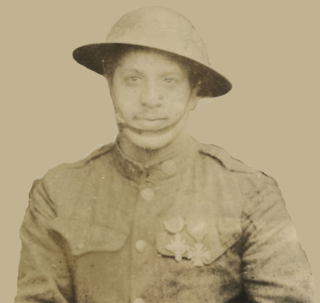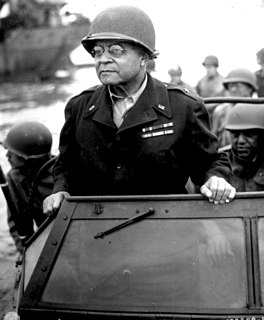 W
WThe 92nd Infantry Division was a segregated infantry division of the United States Army that served in both World War I and World War II. The division was organized in October 1917, after the U.S. entry into World War I, at Camp Funston, Kansas, with African American soldiers from all states. In 1918, before leaving for France, the American buffalo was selected as the divisional insignia due to the "Buffalo Soldiers" nickname, given to African American cavalrymen in the 19th century. The "Buffalo Soldiers Division" divisional nickname was inherited from the 366th Infantry, one of the first units of the division organized.
 W
WThe 370th Infantry Regiment was the designation for one of the infantry regiments of the 93rd (Provisional) Infantry Division in World War I. In World War II, the regiment was part of the 92nd Infantry Division.
 W
WThe 371st Infantry Regiment was a segregated African American regiment, nominally a part of the 93rd Division, that served in World War I under French Army command, and also in World War II in the Italian Campaign as part of the 92nd Infantry Division (Colored). In both wars the unit had primarily African American enlisted men and white officers.
 W
WThe 372nd Infantry Regiment was a segregated African American regiment, nominally a part of the 93rd Division, that served in World War I under French Army command, and also in World War II. In World War II the regiment was not attached to a division, and served in the continental United States (CONUS) and Hawaii. In both wars the unit had primarily African American enlisted men and white officers.
 W
WWhen they returned home from World War I, African-American veterans faced heavy discrimination. This article focuses on those African American veterans who were lynched after World War I.
 W
WCorporal Clarence Van Allen was a war hero from the 372nd Infantry Regiment an all Black unit that fought with honours in World War I. For his bravery under fire he won the Médaille militaire one of a few Americans to do so.
 W
WBenjamin Oliver Davis Sr. was a United States Army officer. In 1940, he became the first African-American to rise to the rank of Brigadier General. He was the father of Air Force General Benjamin O. Davis Jr. according to historian Russell Weigley, his career is significant not for his personal accomplishments, because he was only allowed a limited range of responsibilities, but as an indicator of a small forward movement for Blacks in the American army in the World War II era. The new deal era Franklin Roosevelt was favorable toward Blacks, and in 1940 appointed Davis as the first black general. During World War II Davis held troubleshooting staff assignments designed to assist expanded role of Blacks, albeit in segregated units. He did not have command of troops.
 W
WEdward Dugger was a military commander and prominent African American citizen in Medford, Massachusetts. During his career, he served in World War One, commanded Company K of the 372nd Infantry Regiment ultimately rising to the rank of lieutenant colonel. He was President of the West Medford Men's Community Club and Chair of the Citizen's Committee bringing Boy Scouts Troop No. 11 to the area. Dugger was the first African American to be appointed to the Medford City Planning Board and to have a Medford public park named after him, "Dugger Park." Dugger died in 1939.
 W
WJames Reese Europe, sometimes known as Jim Europe, was an American ragtime and early jazz bandleader, arranger, and composer. He was the leading figure on the African Americans music scene of New York City in the 1910s. Eubie Blake called him the "Martin Luther King of music".
 W
WSusan Elizabeth Frazier was a thought leader on the issues of women's and African Americans' rights and capacity. She was an active and accomplished substitute teacher in New York City Public Schools at a time when such opportunities for African American women were very limited.
 W
WWilliam Henry Johnson, commonly known as Henry Johnson, was a United States Army soldier who performed heroically in the first African American unit of the United States Army to engage in combat in World War I. On watch in the Argonne Forest on May 14, 1918, he fought off a German raid in hand-to-hand combat, killing multiple German soldiers and rescuing a fellow soldier while experiencing 21 wounds, in an action that was brought to the nation's attention by coverage in the New York World and The Saturday Evening Post later that year. On June 2, 2015, he was awarded the Medal of Honor by President Barack Obama in a posthumous ceremony at the White House.
 W
WWilbur Little was a black United States veteran of World War I, lynched in April 1919 in his hometown of Blakely, Georgia, for refusing to remove his military uniform. Servicemen who had been discharged from the army were permitted under War Department regulations to wear their service uniforms for three months after their demobilization date. Reportedly, Little was still in uniform beyond that date. He was one of many African-American servicemen of the time who were subjected to violence for continuing to wear their uniforms after being discharged from the military.
 W
WJames Henry Lyons was a baseball player in the Negro Leagues. He pitched and played outfield between 1910 and 1925. He played for the Brooklyn Royal Giants, Chicago Giants, Lincoln Giants, St. Louis Giants, and Detroit Stars. He is the brother of Bennie Lyons, another baseball player who played for the West Baden Sprudels and Indianapolis ABCs.
 W
WSpottswood Poles was an American outfielder in baseball's Negro leagues. Born in Winchester, Virginia, he died at age 74 in Harrisburg, Pennsylvania.
 W
WNeedham Roberts was an American soldier in the Harlem Hellfighters and recipient of the Purple Heart and the Croix de Guerre for his valor during World War I.
 W
WNoble Lee Sissle was an American jazz composer, lyricist, bandleader, singer, and playwright, best known for the Broadway musical Shuffle Along (1921), and its hit song "I'm Just Wild About Harry".
 W
WStevedore operations were established by the United States Army to provide movement of supplies through ports in support of the American Expeditionary Forces during World War I. The first American stevedores in France were civilians. Stevedores were originally organized into regiments, and were among the first troops sent to France. Three regiments and two separate battalions were deployed, and were later reorganized into separate battalions and transferred from the Army Service Corps to the Transportation Corps. The battalions were inactivated in France and the troops were assigned to companies without a branch affiliation for their return to the U.S.
 W
WFreddie Stowers was an African-American corporal in the United States Army who was killed in action during World War I while serving in an American unit under French command. Over 70 years later, he posthumously received the Medal of Honor and Purple Heart for his actions.